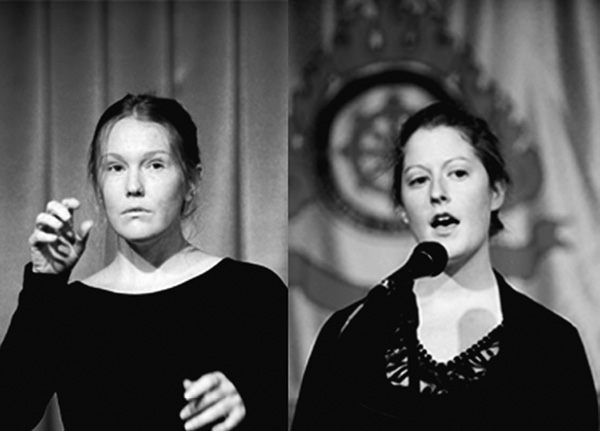
SILENCE AND COMMUNICATION
first performed on November 2, 2012
Nalanda Events Center, Naropa University, Boulder, CO
performed once in 2012
ELYSE BROWNELL
Melissa Mae Smith, Asa Lotterhos
Boulder, CO
837463195e837463195l837463195y837463195s837463195e837463195.837463195b837463195r837463195o837463195w837463195n837463195e837463195l837463195l837463195@837463195g837463195m837463195a837463195i837463195l837463195.837463195c837463195o837463195m
SILENCE AND COMMUNICATION
ELYSE BROWNELL
This performance begins before it starts. As the audience takes their seats, an inconspicuous performer records the sounds of the audience on a two-channel guitar looper connected to a microphone. Each 15-second interval of audience noise is layered four times on channel one. On channel two, a prerecording of an excerpt from “Lecture on Nothing” by John Cage is read in a slow tempo, as Cage wanted it, allowing the piece to be read in an “artificial manner, but with the rubato one uses in everyday speech.”
Fifteen-seconds of the audience recording plays to a black stage. The audience watches their own performance in the blackness of their own static. The recording ends. Two performers enter from opposite sides of the stage as the stage lights come on. They walk toward each other with synchronized movements and stop four inches apart facing each other. One performer begins singing while the other mouths the beginning of “Lecture on Nothing”:
I am here and there is nothing to say
Performers turn to face the audience and perform an excerpt from “Lecture on Nothing” in silence. This allows the audience to experience the performance as the deaf, allowing silence to be the performance. The two performers finish with “we may love them,” and end with their arms to their sides, then exit as they entered.
Stage lights dim.
Ten-seconds of audience recording plays back at a higher volume. A recording of the excerpt is then played to a black stage. The same poem sung to the audience is now the only presence left, in darkness. When the recording ends, 15 seconds of audience recording fades in to maximum volume and then ends abruptly. Silence echoes. The lingering of static is all that is left.
This is all choreographed to four minutes and 33 seconds. Cage’s 4’33” demonstrated what happens when you pay attention to silence, and thus discovering silence does not exist. This performance is another approach to see what happens in the silence of the room, as well as to give the experience of what someone with impaired hearing encounters during readings/performances. The audience recording is included to symbolize that, similar to Cage’s philosophy, a conversation is always occurring between the performers and the audience. This was part of the event, fourthirtythree: CAGED! put on by the Jack Kerouac School of Disembodied Poetics, Naropa University.